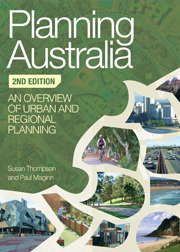Book contents
- Frontmatter
- Contents
- Contributors
- Figures and tables
- Discussion points and case studies
- Preface
- Acknowledgments
- Abbreviations
- Table of statutes
- Introduction
- Part I Frameworks
- Part II Key Issues
- 6 Planning and the natural environment
- 7 The metropolis
- 8 Planning for rural landscapes
- 9 Planning for regions
- 10 Planning for diverse communities
- 11 Aboriginal and Torres Strait Islander Australians
- 12 Community participation in planning
- 13 Urban design
- 14 Planning for heritage conservation and management
- 15 Transport planning
- 16 Healthy planning
- Conclusion: planning Australia into the future
- Index
- References
12 - Community participation in planning
from Part II - Key Issues
- Frontmatter
- Contents
- Contributors
- Figures and tables
- Discussion points and case studies
- Preface
- Acknowledgments
- Abbreviations
- Table of statutes
- Introduction
- Part I Frameworks
- Part II Key Issues
- 6 Planning and the natural environment
- 7 The metropolis
- 8 Planning for rural landscapes
- 9 Planning for regions
- 10 Planning for diverse communities
- 11 Aboriginal and Torres Strait Islander Australians
- 12 Community participation in planning
- 13 Urban design
- 14 Planning for heritage conservation and management
- 15 Transport planning
- 16 Healthy planning
- Conclusion: planning Australia into the future
- Index
- References
Summary
Key terms: community participation; public involvement; representative democracy; public; stakeholders; public interest; citizens; government; governance; community; consultation; engagement; evaluation; information and communication technology; internet.
Is planning something done for people? Or is it done to them? Or should planning, in fact, be something done with people? A fundamental principle of representative democracies is that elected individuals should be responsible for, and able to represent, the interests of those who elected them. In the context of planning, elected representatives – whether at the local, state or national level of government – ideally reach a consensus on planning programs, policies and implementation, and work to ensure an equitable, accessible, nurturing and improved quality of life for all their constituents (Healey 2006; Innes 1994). ‘Planning with people’ should therefore be a guiding principle and logical process. Unfortunately, governance and planning have seldom worked so smoothly. In fact, because representative democracy does not always represent all community interests, public involvement in planning has arguably become one of the most significant and debated issues in planning processes.
When the people who are being planned for begin to feel that they have little say in or control over planning processes – that, in fact, planning is something being done to them – the planning process and the need for greater public involvement must be questioned. According to the World Bank, public involvement can be defined as ‘a process for involving the public in the decision-making process of an organisation. This can be brought about through either consultation or participation, the key difference being the degree to which those involved in the process are able to influence, share or control the decision-making’ (World Bank 1993, p. 5) (emphasis added).
- Type
- Chapter
- Information
- Planning AustraliaAn Overview of Urban and Regional Planning, pp. 276 - 293Publisher: Cambridge University PressPrint publication year: 2012
References
- 5
- Cited by

